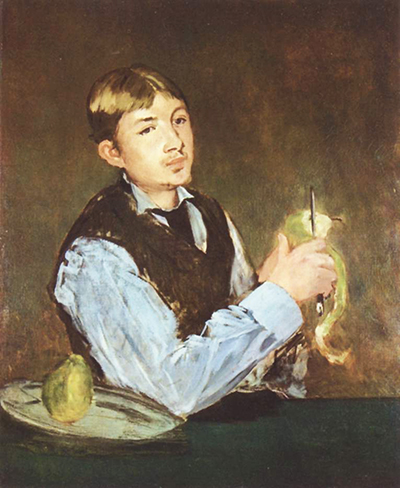The painting, Young Man Peeling a Pear, evidently illustrates the title of the piece as it showcases a young man peeling a pear in an impressionism painting.
The young man within the painting is Leon, the son of Edouard and Suzanne Manet. The piece was painted roughly around 1869, and illustrates an array of different techniques and emotions within the piece. Leon was often the muse of Painter Manet in an array of locations within his work. Leon is located with Manet's paintings Reading, The Bicycle, and Boy With a Sword. These images showcase a certain popular style among the 19th century, illustrating paintings of common acts and people to the painter.
The idea behind the painting, Young Man Peeling A Pear, mostly likely occurred based on Manet’s every day life, finding the beauty within the most common acts of life. With a history of family dysfunction, and rumours that Manet’s son Leon was in fact the son of his father and infidel wife, Suzanne, the piece illustrates a moment of calmness for Manet, painting his son. The painting illustrates a young man, sitting at a table and peeling a pear as he stares off into the distance. Leon’s arm is strategically placed at an angle, arching his body as he wears a baby blue coloured dress shirt, accompanied by a brown vest.
In the middle tucked under his vest, Leon wears a black tie. Each of these pieces the muse is dressed in is separately painted in different textures to showcase a wide array of fabric and tones. It seems as it Leon’s blue dress shirt is lightly stripped with another shade of blues. Leon inherited a blonde coloured hair, after his father, and wears it sleeked to the side as it parts in the middle. Leon’s face is painted in am immense amount of detail, showcasing every line and cavern located on his face. The muse has a minor moustache growing, suggesting the piece was painted during Leon’s entrance into a phase of adolescence.
The boy looks to the side, away from the viewer while still acknowledging their presence as a muse. Again, the detail on Leon’s face is immensely illustrated as Manet incorporates different techniques of shade and light, contouring the outside of his face while highlighting the inner part bringing in brightness. Leon seems to be peeling the green skin of a pair with a knife, while the other fruit lies on the table to the left of the painting. The essence the painting gives off is a welcoming allure, showcasing a normal event of the 19th century, and a glimpse in Manet’s everyday life.




